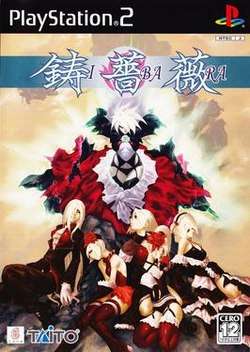Ibara (video game)
Ibara (鋳薔薇) is a 2005 vertical scrolling shooter developed by Japanese developer Cave and published by Taito. It was ported to the PlayStation 2 in 2006.
| Ibara | |
|---|---|
 PlayStation 2 cover art | |
| Developer(s) | Cave |
| Publisher(s) | AMI (arcade) Taito Corporation (PS2) |
| Director(s) | Shinobu Yagawa |
| Producer(s) | Kenichi Takano |
| Designer(s) | Akira Wakabayashi |
| Programmer(s) | Shinobu Yagawa |
| Artist(s) | Toshiyuki Kotani |
| Composer(s) | Shinji Hosoe |
| Platform(s) | Arcade, PlayStation 2 |
| Release | Arcade
|
| Genre(s) | Scrolling shooter |
| Mode(s) | Single player, two-player co-op |
| Cabinet | Upright |
| Arcade system | CAVE CV1000B |
| CPU | Hitachi SH-3 CPU @ 133 MHz |
| Sound | Yamaha YMZ770C-F (APU) |
| Display | Vertical orientation |
Gameplay
Ibara is very similar to 8ing/Raizing's Battle Garegga and Battle Bakraid games. So much so that Ibara could be considered a pseudo-sequel or, at least, a spiritual successor. The similarities are numerous - some are subtle, some are easily spotted. These include combining archaic technology such as biplanes with more advanced machinery; firing and a power-up system; and a medal collecting system which drastically increases scoring. The game features a similar method of earning bombs and a delay when launching them as well. Some of the enemies and their attack patterns are very familiar such as the large cranes in stage 1 and the minigun-wielding first boss. The enemy's explosions spiral around when destroying some of the heavier weapons/scenery and thin, while seemingly camouflaged enemy bullets are scattered around the play area in comparable patterns. More subtle references include the HUD layout which lists the name of the current stage at the top of the screen and, when starting a stage, tells users the title of the background music that is playing.
A notable feature of Ibara is the inclusion of a variable, real-time difficulty system by way of the Rank system. The player's rank increases as they acquire more items and cause more damage, increasing the difficulty of the game along with it. The number of enemies does not increase but the number of bullets fired towards the user does, often reaching a ridiculous level of bullet density. There are ways of lowering this rank system if the odds appear too much. The only known way of decreasing the player's Rank in Ibara is to die. The more lives you have, the less the rank decreases when you die. In the later version, Ibara Kuro: Black Label, Rank can be decreased by cancelling bullets with a bomb, however Rank also increases much faster in this version, potentially increasing from minimum to maximum in a matter of seconds.
Plot
Release
The game was released in arcades in July 15, 2005, and it was released on the PlayStation 2 on February 23, 2006.[2]
To remedy some of the concerns fans had with the original version of the game, Cave released an updated version in limited distribution called Ibara Kuro: Black Label. It was released on February 10, 2006.[3] The update contains many additions, some of which appeared earlier in the released PlayStation 2 port in the form of Arrange Mode.
A sequel, Pink Sweets: Ibara Sorekara, was released in the arcades on April 21, 2006.[4]
Reception
Weekly Famitsu magazine awarded the PlayStation 2 version of Ibara a score of 26/40 based on four reviews (7/7/6/6).[5][2]
References
- "A guide to gaming's most valuable treasures". Eurogamer.net. Retrieved 2018-08-02.
- "鋳薔薇 [PS2] / ファミ通.com". www.famitsu.com. Retrieved 2018-08-02.
- "鋳薔薇黒 ブラックレーベル [アーケード] / ファミ通.com". www.famitsu.com. Retrieved 2018-08-02.
- "ピンクスゥイーツ〜鋳薔薇それから〜 [アーケード] / ファミ通.com". www.famitsu.com. Retrieved 2018-08-02.
- Riley, Adam (February 15, 2006). "Baten Kaitos Gets Top Honours From Famitsu". Cubed3. Retrieved April 11, 2015.
External links
- Official websites for Arcade and PlayStation 2 at the Wayback Machine (archived April 27, 2006) versions (in Japanese)